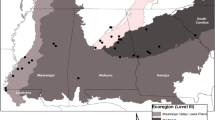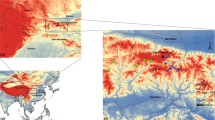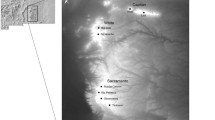Abstract
Montane regions can promote allopatric speciation and harbor unique species with small ranges. The southern Appalachians are a biodiversity hotspot for salamanders, and several montane endemics occur in the region. Here, we present the first DNA sequence data for Plethodon sherando, a terrestrial salamander recently discovered in the Blue Ridge Mountains of Virginia. We sequenced two mitochondrial regions (cyt-b and CO1) from salamanders at reference sites near the center of P. sherando’s range and from two contact zones where P. sherando populations are replaced by Plethodon cinereus, the Northern Red-Backed salamander. We then used these sequence data to examine divergence and hybridization between the two taxa. We found P. sherando and P. cinereus morphotypes from contact zones to be reciprocally monophyletic and highly divergent (~17%). P. sherando exhibited very low sequence diversity (π = 0.0010) as compared to P. cinereus from the same locations (π = 0.0096). Salamander morphology in the contact zone was as distinct as morphology at reference sites, and discriminant function analysis based on morphology successfully classified 98% of salamanders to their mitochondrial lineage. Phylogenetic analysis of cyt-b sequences showed P. sherando to be sister to Plethodon serratus (the Southern Red-Backed salamander) rather than P. cinereus or any nearby mountaintop endemics. Our results suggest that P. sherando is a distinct lineage that is not subject to substantial introgression from P. cinereus and that may have a history of geographic isolation. Given its limited range (<80 km2), we believe P. sherando should merit a conservation status similar to that of other mountaintop salamanders in the region.





Similar content being viewed by others
References
Adams DC (2004) Character displacement via aggressive interference in Appalachian salamanders. Ecology 85:2664–2670
Adams DC, West ME, Collyer ML (2007) Location-specific sympatric morphological divergence as a possible response to species interactions in West Virginia Plethodon salamander communities. J Anim Ecol 76:289–295
Anderson E, Maldonado-Ocampo J (2010) A regional perspective on the diversity and conservation of the tropical Andean fishes. Conserv Biol 25:30–39
Arif S, Wicknick JA, Adams DC (2007) Bioclimatic modeling, morphology, and behavior reveal alternative mechanisms regulating the distributions of two parapatric salamander species. Evol Ecol Res 9:843–854
Babik W, Branicki W, Crnobnja-Isailović J, Cogălniceanu D, Sas I, Olgun K, Poyarkov NA, Garcia-País M, Arntzen JW (2005) Phylogeography of two European newt species—discordance between mtDNA and morphology. Mol Ecol 14:2475–2491
Bensasson D, Zhang D-X, Hartl DL, Hewitt GM (2001) Mitochondrial pseudogenes: evolution’s misplaced witnesses. Trends Ecol Evol 16:314–321
Cabe P, Hanlon T, Aldrich M, Connors L, Marsh D (2007) Fine-scale population differentiation and gene flow in a terrestrial salamander (Plethodon cinereus) living in continuous habitat. Heredity 98:53–60
Carpenter D, Jung R, Sites J (2001) Conservation genetics of the endangered Shenandoah Salamander (Plethodon shenandoah, Plethodontidae). Anim Conserv 4:111–119
Chan C, Ballantyne K, Aikman H, Fastier D, Daugherty C, Chambers G (2006) Genetic analysis of interspecific hybridization in the world’s only Forbes’ parakeet (Cyanoramphus forbesi) natural population. Conserv Genet 7:493–506
Colliard C, Sicilia A, Turrisi G, Arculeo M, Perrin N, Stöck M (2010) Strong reproductive barriers in a narrow hybrid zone of west-mediterranean green toads (Bufo viridis subgroup) with Plio-Pleistocene divergence. BMC Evol Biol 10:232
Connors LM, Cabe PR (2003) Isolation of dinucleotide microsatellite loci from red-backed salamanders (Plethodon cinereus). Mol Ecol Notes 3:131–133
Degnan JH, Rosenberg NA (2009) Gene tree discordance, phylogenetic inference, and the multispecies coalescent. Trends Ecol Evol 24:332–340
Drummond AJ, Rambaut A (2007) BEAST: Bayesian evolutionary analysis sampling trees. BMC Evol Biol 7:214
Duellman WE, Sweet SS (1999) Distribution patterns of amphibians in the Nearctic region of North America. In: Duellman WE (ed) Patterns of distribution of amphibians. Johns Hopkins Univ. Press, Baltimore, pp 31–109
Felsenstein J (1993) PHYLIP (Phylogeny Inference Package) version 3.5c. Distributed by the author. Department of Genetics, University of Washington, Seattle
Fraley C, Raftery AE (2006) MCLUST version 3 for R: normal mixture modeling and model-based clustering. Technical report. Department of Statistics, University of Washington, Seattle
Gilman SE, Urban MC, Tewksbury J, Gilchrist GW, Holt RD (2010) A framework for community interactions under climate change. Trends Ecol Evol 25:325–331
Harpending RC (1994) Signature of ancient population growth in a low-resolution mitochondrial DNA mismatch distribution. Hum Biol 66:591–600
Hastie T, Tibshirani R, Friedman JH (2001) Elements of statistical learning. Springer, New York
Hebert PDN, Penton EH, Burns JM, Janzen DH, Hallwachs W (2004) Ten species in one: DNA barcoding reveals cryptic species in the neotropical skipper butterfly Astraptes fulgerator. PNAS 101:14812–14817
Hegde SG, Nason JD, Clegg JM, Ellstrand NC (2006) The evolution of California’s wild radish has resulted in the extinction of its progenitors. Evolution 60:1187–1197
Highton R (1995) Speciation in Eastern North American salamanders of the genus Plethodon. Annu Rev Ecol Syst 26:579–600
Highton R (1998) Frequency of hybrids between introduced and native populations of the salamander Plethodon jordani in their first generation of sympatry. Herpetologica 54:143–153
Highton R (1999) Geographic protein variation and speciation in the salamanders of the Plethodon cinereus group with the description of two new species. Herpetologica 55:43–90
Highton R (2004) A new species of woodland salamander of the Plethodon cinereus group from the Blue Ridge Mountains of Virginia. Jeffersoniana 14:1–22
Highton R, Worthington R (1967) A new salamander of the genus Plethodon from Virginia. Copeia 1967:617–626
Huelsenbeck JP, Ronquist F (2001) MRBAYES: Bayesian inference of phylogeny. Bioinformatics 17:754–755
Jaeger RG, Forester DC (1993) Social behavior of plethodontid salamanders. Herpetologica 49:163–175
Johnson JA, Dunn PO, Bouzat JL (2007) Effects of recent population bottlenecks on reconstructing the demographic history of prairie chickens. Mol Ecol 16:2203–2222
Kleindorfer S, Chapman TW, Winkler H, Sulloway FJ (2006) Adaptive divergence in contiguous populations of Darwin’s Small Ground Finch (Geospiza fuliginosa). Evol Ecol Res 8:357–372
Knowles L (2001) Did the Pleistocene glaciations promote divergence? Tests of explicit refugial models in montane grasshopprers. Mol Ecol 10:691–701
Kozak K, Wiens J (2006) Does niche conservatism promote speciation? A case study in North American salamanders. Evolution 60:2604–2621
Kozak KH, Wiens JJ (2010) Niche conservatism drives elevational diversity patterns in Appalachian salamanders. Am Nat 176:40–54
LaSorte F, Jetz W (2010) Projected range contractions of montane biodiversity under global warming. Proc R Soc B Biol Sci 277:3401–4310
Lawler JJ, Shafer SL, White D, Kareiva P, Maurer EP, Blaustein AR, Bartlein PJ (2009) Projected climate-induced faunal change in the Western Hemisphere. Ecology 90:588–597
Lovett JC (1998) Continuous change in Tanzanian moist forest tree communities with elevation. J Trop Ecol 14:719–722
Mallet J (2005) Hybridization as an invasion of the genome. Trends Ecol Evol 20:229–237
Mallet J, Beltrán M, Neukirchen W, Linares M (2007) Natural hybridization in heliconiine butterflies: the species boundary as a continuum. BMC Evol Biol 7:28
Marsh D, Page RB, Hanlon TJ, Corritone R, Little EE, Seifert DE, Cabe PR (2008) Effects of roads on patterns of genetic differentiation in red-backed salamanders, Plethodon cinereus. Conserv Genet 9:603–613
McCain CM (2005) Elevational gradients in diversity of small mammals. Ecology 86:366–372
Milanovich J, Peterman W, Nibbelink N, Maerz J (2010) Project loss of a salamander diversity hotspot as a consequence of project global climate change. PLoS ONE 5:e12189
Moritz C, Patton JL, Conroy CJ, Parra JL, White GC et al (2008) Impact of a century of climate change on small-mammal communities in Yosemite National Park, USA. Science 322:261–264
Mueller R (2006) Evolutionary rates, divergence dates, and the performance of mitochondrial genes in Bayesian phylogenetic analysis. Syst Biol 55:289–300
Myers N, Mittermeier R, Mittermeier C, Fonseca G, Kent J (2000) Biodiversity hotspots for conservation priorities. Nature 403:853–858
Pauley T (2007) Revised notes on the range of the Cheat Mountain Salamander, Plethodon nettingi. Proc W Va Acad Sci 79:16–21
Petranka JW (1998) Salamanders of the United States and Canada. Smithsonian Institution Press, Washington
Posada D (2008) jModelTest: phylogenetic model averaging. Mol Biol Evol 25:1253–1256
Rhymer J, Simberloff D (1996) Extinction by hybridization and introgression. Annu Rev Ecol Syst 27:83–109
Rissler LJ, Smith WH (2010) Mapping amphibian contact zones and phylogeographic break hotspots across the United States. Mol Ecol 19:5404–5416
Ronquist F, Huelsenbeck JP (2003) MRBAYES 3: Bayesian phylogenetic inference under mixed models. Bioinformatics 19:1572–1574
Rozas J, Sanchez-DelBarrio JC, Messeguer X, Rozas R (2003) DnaSP, DNA polymorphism analyses by the coalescent and other methods. Bioinformatics 19:2496–2497
Schneider S, Excoffier L (1999) Estimation of past demographic parameters from the distribution of pairwise differences when the mutation rates vary among sites: application to human mitochondrial DNA. Genetics 152:1079–1089
Smith MA, Poyarkov NA, Hebert PDN (2008) CO1 DNA barcoding amphibians: take the chance, meet the challenge. Mol Ecol Resour 8:235–246
Steele C, Carstens BC, Storfer A, Sullivan J (2005) Testing hypotheses of speciation timing in Dicamptodon copei and Dicamptodon aterrimus (Caudata: Dicamptodontidae). Mol Phylogenet Evol 36:90–100
Szymura JM, Uzzell T, Spolsky C (2000) Mitochondrial DNA variation in the hybridizing fire-bellied toads, Bombina bombina and B. variegata. Mol Ecol 9:891–899
Tamura K, Dudley J, Nei M, Kumar S (2007) MEGA4: molecular evolutionary genetics analysis (MEGA) software version 4.0. Mol Biol Evol 24:1596–1599
Terborgh J (1977) Bird species diversity on an Andean elevational gradient. Ecology 58:1007–1019
United States Forest Service (2011) George Washington National Forest plan revision. http://www.fs.fed.us/. Accessed 11 November 2011
Weisrock D, Kozak H, Larson A (2005) Phylogeographic analysis of mitochondrial gene flow and introgression in the salamander, Plethodon shermani. Mol Ecol 14:1457–1472
Wiens J, Engstrom T, Chippindale P (2006) Rapid diversification, incomplete isolation, and the “speciation clock” in North American Salamanders (genus Plethodon): testing the hybrid swarm hypothesis of rapid radiation. Evolution 60:2585–2603
Wilson R, Gutiérrez D, Gutiérrez J, Monserrat V (2007) An elevational shift in butterfly species richness and composition accompanying recent climate change. Glob Change Biol 3:1873–1887
Xu T, Abbot R, Milne R, Mao K, Du F, Wu G, Ciren Z, Miehe G, Liu J (2010) Phylogeography and allopatric divergence of cypress species (Cupressus L.) in the Qinghai-Tibetan Plateau and adjacent regions. BMC Evol Biol 10:194
Acknowledgments
We thank Shane Ramee and members of the 2009 Field Herpetology class for help with collecting salamanders. Briana Gregory and Woodrow Friend assisted with DNA extractions and Jennifer Schieltz and Caroline Bovay contributed to the GIS analysis. We thank Richard Highton, Nadia Ayoub, and two anonymous reviewers for helpful comments on earlier drafts of this manuscript. This research was covered by Virginia state collection permit #33510 and IACUC animal care and use permit DM0109. Financial support for this study was provided by the U.S. Forest Service, a Howard Hughes Medical Institute award to Washington & Lee University under the Undergraduate Science Education Program, and an H. F. Lenfest grant to D Marsh.
Author information
Authors and Affiliations
Corresponding author
Rights and permissions
About this article
Cite this article
Bayer, C.S.O., Sackman, A.M., Bezold, K. et al. Conservation genetics of an endemic mountaintop salamander with an extremely limited range. Conserv Genet 13, 443–454 (2012). https://doi.org/10.1007/s10592-011-0297-7
Received:
Accepted:
Published:
Issue Date:
DOI: https://doi.org/10.1007/s10592-011-0297-7




